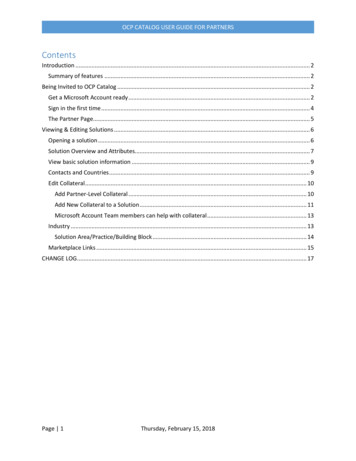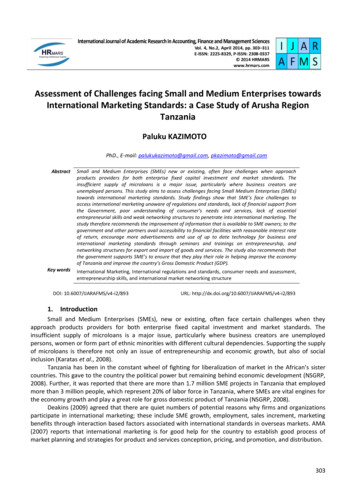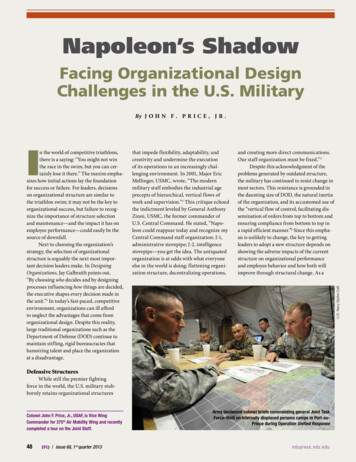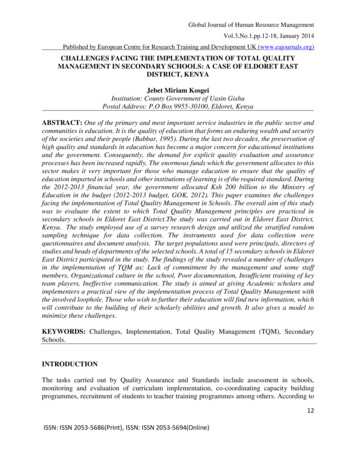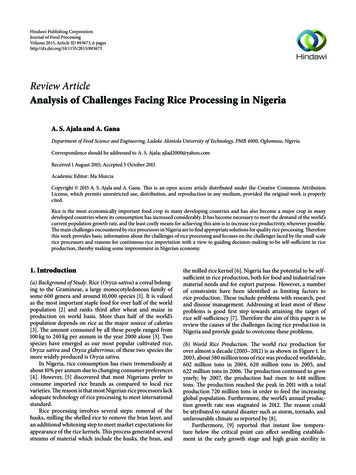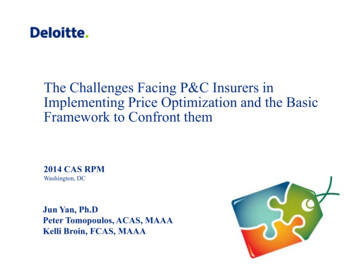
Transcription
The Challenges Facing P&C Insurers inImplementing Price Optimization and the BasicFramework to Confront them2014 CAS RPMWashington, DCJun Yan, Ph.DPeter Tomopoulos, ACAS, MAAAKelli Broin, FCAS, MAAA
AgendaWhy Price Optimization?Price Optimization is Far Beyond a Mathematically Optimized PricePrice Optimization FrameworkChallenges Insurers Face Implementing Price OptimizationConcluding Remarks1Deloitte Consulting LLPConfidential and Proprietary – Copyright 2014 – Deloitte Development LLP
Why Price Optimization?2Deloitte Consulting LLPConfidential and Proprietary – Copyright 2014 – Deloitte Development LLP
Balancing premium volume with target loss ratio Traditionally, insurance companies and actuaries have relied on the insured’s expectedclaim cost along with claims history (experience rating) and underwriter judgment(schedule rating) to determine the appropriate premium. Price optimization integrates the risk’s insurance price and the market demand forinsurance. Market demand reflects:CustomerBehaviorElasticity ofDemandCompetitorPricing Price optimization enables control of balancing premium volume and loss ratio– Can increase premium volume without impacting the target loss ratio, OR– Can decrease target loss ratio without impacting premium volumePremiumLossRatioPremiumLoss RatioOR3Deloitte Consulting LLPConfidential and Proprietary – Copyright 2014 – Deloitte Development LLP
Three levels of pricing sophisticationInsurance pricing can be classified in three levels of sophistication:Basic Rating Plans, Underwriting Models, and Market Demand ModelsPrice OptimizationIncreasing SophisticationPricingLevels1. Basic Rating Loss cost (pure premium)model based on exposureand traditional ratingvariablesComponentsof PricingLevels4 Rating variables driven byindustry and regulatoryrestrictionsDeloitte Consulting LLP2. Underwriting3. Market Demand Refinement of Level 1 (basicrating) loss cost estimate Reflects strategic, regulatory,and market constraints Generally used to rationalizethe process of assigning tiers,credits, debits and companyplacement Builds upon results from Level 2(underwriting) and Level 1 (basicrating) Predictive variables could berating and non rating frominternal and external datasources Applies customer price elasticityto optimize priceConfidential and Proprietary – Copyright 2014 – Deloitte Development LLP
Current market capabilitiesInsurers have instituted basic forms of price optimization techniques in recent years, butfew have integrated them within a strategic and operations pricing platform needed toovercome challenges to successfully implement optimization techniquesPrice OptimizationCurrent Market Capabilities Very few companies have fully developed such integrated platforms Most companies have some level of competitive pricing insights but lack integration with customer andmarket demand behaviorPricingLevelsCurrentMarketCapabilities51. Basic Rating2. Underwriting3. Market Demand Vast majority of companieshave sufficient or leadingpractice capabilities in rating There is a large degree ofvariability in approachescompanies take in this area Some companies may havedeveloped customer demandmodels Ability to rerate historicalbook (in-force and lapsedpolicies) varies by company Most companies have somecapability but generally notintegrated with customerbehavior Very few companies havedeveloped a well integratedplatform for operationDeloitte Consulting LLPConfidential and Proprietary – Copyright 2014 – Deloitte Development LLP
Key concerns impacting implementationAs insurers attempt or have attempted to optimize their rates, key concerns have beenidentified that are becoming critical for companies to address to incorporate these priceoptimization techniques in their pricing structures.Key Concerns6Ignoring underwriter adjustmentsBy not reflecting the individual riskcharacteristics at a policy level, manyof the characteristics are not reflectedin base rating.Large-scale effort to implementLarge amount of data to collect, storeand analyze; and then, how do youreact to all that information?Difficulty to monitor and measureAs more characteristics areconsidered in an optimization model,the result will become a “black box”and hard to understandRestrictions for commercial linesInformation on final price is limitedDeloitte Consulting LLPConfidential and Proprietary – Copyright 2014 – Deloitte Development LLP
A different view to deal with the core challengesWhen a strategic and operational pricing platform effectively integrates profitability,market demand and customer price elasticity, it will allow insurers to successfully managefuture market cycles and dynamicsPrice OptimizationEvolving Practices Platform enables dynamic analysis of risk, profitability and growth simultaneously Platform allows for scenario testing to assist in operation and strategic decision making of price changesfor highly segmented marketPricingLevelsEvolvingCapabilities71. Basic Rating Well developed loss costbased rating that generatetens of thousands ofindividual marketsegments/price points Companies can easily rerate entire historical book forany rating changeDeloitte Consulting LLP2. Underwriting Reflect risks at the individualpolicy level in pricing a policy Companies have ability toeffectively generate andcapture competitive rates foreach policy and new businessquote3. Market Demand Data from rating andunderwriting components alongwith new business and renewaldata, and data from competitivemarkets can be used to developcustomer price elasticity andmarket demand curves. Curve is combined with segment/tiering analyses to refineknowledge of customer behaviorand to take appropriate actionsConfidential and Proprietary – Copyright 2014 – Deloitte Development LLP
Price Optimization is Far Beyonda Mathematically Optimized Price8Deloitte Consulting LLPConfidential and Proprietary – Copyright 2014 – Deloitte Development LLP
Questions for overall designBefore designing a price optimization model, there are leading strategic questionsinsurers need to considerLeading QuestionDoes price optimization have to be asoftware driven black box? Wheredoes the Operations Researchsoftware kick in?Expected Outcomes1)2)3)1)What if a price optimization is atransparent process, but not a blackbox?How can we turn a software drivenprice optimization process to be acontrollable open box?9Deloitte Consulting LLP2)3)1)2)Demand modelingLoss cost estimation or loss ratioestimationIntegration of loss cost and demandingfor optimized pricingPrice optimization process should betotally manageable and controllableThe performance of price optimizationwill be easily monitoredPrice optimization will not be purely amathematical result; it will turn to be adecision making tool for strategic pricingSimplify the focus of price optimizationCreate a simple segmentationspecifically for price optimizationConfidential and Proprietary – Copyright 2014 – Deloitte Development LLP
Questions for overall design - ContinuedBefore designing a price optimization model, there are leading strategic questionsinsurers need to considerLeading QuestionWhat is the ultimate goal of priceoptimization?What are the major premiumcomponents?What are the major components forprice optimization?10 Deloitte Consulting LLPExpected Outcomes1)2)Increase Profit (decrease loss ratio)Increase premium volume1)2)3)BenchmarksUnderwriting adjustmentsMarket adjustment1)Risk premium with expenses beforemarket adjustment ( 85%)Premium adjustment based oncustomer demanding and marketcompetition ( 15%)2)Confidential and Proprietary – Copyright 2014 – Deloitte Development LLP
Benefits of a risk-based approachAn approach that directly incorporates underwriting adjustments into determining a pricefor insurance offers a number of key advantagesQuotePrice11 Deloitte Consulting LLPPrice ComponentsSourceOutputBasic RatingRating ents /Underwriting TiersTechnicalPriceMarketDemandMarket DemandAdjustmentMarket PriceConfidential and Proprietary – Copyright 2014 – Deloitte Development LLP
Advantages of including underwriting componentsThe platform is built on a policy level where projected loss ratio, estimated conversion /retention rate, and estimated price elasticity are scored for each policy, which can then besegmented for further optimizationBasic RatingUnderwriting Pricing By coverage, on exposure level Rated on the policy level To be used in rating To be used to identify rating plan deficiency Target: Loss Cost Target: Loss Ratio based on manual premium Factor based point estimation Loss ratio ranking and lift curve basedestimation Not separated by new business and renewalbusiness Separated by new business and renewalbusiness Only using regulated rating variables Much wider range of variables are applied Rating lookup tables are fixed in ITimplementation Lookup tables are dynamically adjusted in ITimplementationA key advantage of including underwriting components is that the insured’s priceelasticity and demand behavior is on the final price at the policy level and not thecoverage and sub-component level. Optimizing price on the sub-coverage levelcreates a gap between the results and the insured’s price behavior.12 Deloitte Consulting LLPConfidential and Proprietary – Copyright 2014 – Deloitte Development LLP
Price Optimization Framework13 Deloitte Consulting LLPConfidential and Proprietary – Copyright 2014 – Deloitte Development LLP
Rely on comparative raters to provide insight intoinsurers’ rates and relative position to your own ratesUsing competitor rates relative to your own and tracking win/loss rates, a price elasticity /demand curve can be createdIllustrative Price Points forIndividual Risks25New Business Conversion Rate & Price Elasticity1.81.620Price Elasticity1.4Price PointConversion y123Individual RiskComp. 1Comp. 2Comp. 345Comp. 40Price Difference with Competitors Examine company’s price versus competitor prices on individual risks and win/loss Plot win rate versus price position to determine basic price elasticity curve Can be segmented by customer type, sales channel (e.g. on-line, agent), income, region, etc.14 Deloitte Consulting LLPConfidential and Proprietary – Copyright 2014 – Deloitte Development LLP
Optimize pricing decisions based on UW tier groupsIntegrating output from an UW predictive model with the demand curve yields a platformfor insurance companies to make and optimize their pricing decisions based onunderwriting tier groups.Integrate risk-based approach using output from Underwriting scoring engine Incorporates variables that are predictive of risk and cost but that cannot be used in traditional ratemaking Analyzes risks at the policy level, not coverage levelTier Tier Factor-0.40-0.38-0.34-0.30-0.28-0.26-0.24-0.20 15 Deloitte Consulting LLPConfidential and Proprietary – Copyright 2014 – Deloitte Development LLP
Pricing lab for scenario testingThe pricing lab provides a simple framework for companies to perform scenario analysisand to drive business decisions that align with the company‘s strategic goals, whilebalancing profit and growthInputsApplicationsBy dimension (profitability & elasticity): Underwriting Tier & CorrespondingTier Factor Manual Premium Target Loss Ratio Estimated Loss Cost Testing and comparing pricingstrategies Optimizing pricing relatedunderwriting rules Competitor Pricing Information Price Elasticity and Demand ModelsA pricing lab will produce a matrix for each scenario showing the premium and lossratio impacts for each combination of dimensions.16 Deloitte Consulting LLPConfidential and Proprietary – Copyright 2014 – Deloitte Development LLP
Tier optimization strategyA tier optimization strategy simplifies the decision making process by evaluating only 2-3dimensions, which then allows for ease of evaluating the impact of changes postimplementation. Pricing is adjusted through a re-placement of the underwriting tier.Actions to increase profitability/volumeHighNo priceChangeElasticityLowLowHighProfitability Decrease price for profitable risks; increase price for unprofitable risks Give more favorable change for risks with high elasticity (more sensitive to price), less favorablechange for risks with low elasticity (less sensitive to price)17 Deloitte Consulting LLPConfidential and Proprietary – Copyright 2014 – Deloitte Development LLP
Pricing lab exampleThe following example demonstrates the pricing lab for a 2 x 2 matrixProfitable SegmentsNew StrategyCurrent StrategyPlatformHigh ElasticityOverallUnprofitable SegmentsLow ElasticityHigh ElasticityLow ElasticityManual Premium(1a)1,0001,20020002500Target Loss Ratio(1b)0.680.680.680.68Underwriting Tier Adjustment(1c)-0.30-0.260.220.32Number of Quotes(2)2,0001,00015001200Price elasticity(3)90.0%75.0%10.0%5.0%Loss Cost per Policy(4) (1a)*(1b)*(1c)4766041,6592,244Underwriting Tier(5a)UW Tier 1.101.151.20Conversion rate(7)22.0%20.0%10.0%8.0%15.5%Converted customer number(8) (2)*(7)44020015096886Average Premium charged(9) (1a)*(5b)7008882,4403,300Premium revenue(10) (8)*(9)308,000177,600366,000316,8001,168,400Loss Ratio(11) (4)*(8)/(10)68.00%68.00%68.00%68.00%68.00%Adjusted UW Tier(13a)Adjusted UW Tier Factor(13b)30.6650.72211.32251.46w/competitors(14) (13)/(5b)*(6)0.941.071.241.33Projected Conversion Rate(14)/(6))*(3)27.1%22.0%9.2%7.5%17.4%Converted customer number(16) (2)*(15)54322013890990Average Premium charged(17) (1)*(13)6608642,6403,650Premium revenue(18) (16)*(17)358,286190,314363,541327,1731,239,313Loss Ratio(19) ice differentiation w/Premium differentiation18 Deloitte Consulting LLPConfidential and Proprietary – Copyright 2014 – Deloitte Development LLP
Pricing rule comparisonThe pricing lab also allows companies to compare strategies for targeted segments rentPremium Loss RatioTargetTargetLoss Ratio:LR:72%73.0%w/o Youthful / Youthful Driverw/o Youthful DriverScenario #1533,78373.6%1 TierNo changeScenario #2499,93172.1%3 TiersNo changew/ Youthful DriverScenario #3531,41173.1%High ElasticityLow ElasticityHigh ElasticityLow Elasticity2 Tier4 Tiers1 TiersNo changePrice IncreasePrice DecreaseThe pricing lab allows the company to understand what the impact of pricing alignments are incoordination with goals for marketing, product and actuarial19 Deloitte Consulting LLPConfidential and Proprietary – Copyright 2014 – Deloitte Development LLP
Challenges Insurers Face ImplementingPrice Optimization20 Deloitte Consulting LLPConfidential and Proprietary – Copyright 2014 – Deloitte Development LLP
Key considerations to implement price optimizationThe challenges to implement price optimization techniques will vary in complexity andsignificance based on specific key considerationsChallengesOperationalData CollectionData AnalysisRegulatoryKey ConsiderationsStrategy:Premium Volume vs.Loss RatioLines of Business:Personal vs.Small to Mid-SizedCommercialCustomer Segment:New Business vs.Renewals21 Deloitte Consulting LLP What is the insurer’s strategy? Are they looking to implementprice optimization in order to decrease loss ratio or to increasepremium volume? Insurers will need to find the right balance between premiumvolume and loss ratio that fits their strategy While more internal and external (and credible) information isavailable to personal lines insurers, commercial lines insurersface fewer external constraints from regulators and customers. Commercial lines pricing also provides more flexibility in rating apolicy through underwriter judgment Important to model separately the renewal business vs. newbusiness as customer preferences vary between the two groups. It is important to understand how customers react to pricechanges for renewal business and monitor how changing ratelevels affect new businessConfidential and Proprietary – Copyright 2014 – Deloitte Development LLP
Whiteboard – what specific challenges have you faced orare facing to implement price optimization?Operational22 Deloitte Consulting LLPData CollectionData AnalysisRegulatoryConfidential and Proprietary – Copyright 2014 – Deloitte Development LLP
Operational challengesOperationalData CollectionData AnalysisKey ChallengesRegulatoryPotential Solutions Actuarial, Product, Marketing, Sales andIT will need to be aligned on strategy toincorporate into existing pricing platform Price optimization strategies must alignwith the broader strategic objectives onprofit and growth goals Use a pricing lab to monitor theimpact of rules and rate changes oncustomer segments Use existing underwriting predictivemodeling techniquesTechnologyIntegration Insurance companies are still transitioningfrom legacy systems that may not be able tosupport price optimization techniques Many systems will be impacted by priceoptimization:Training andKnowledgeTransfer Sales force and customer servicerepresentatives have to learn a new approachto selling and servicing a policy Staff needs to be able to understand thebasics of the optimization techniques Use price optimization as anotherunderwriting tool under existingtechniques such as underwriting tiergroup re-placementAlignment withStrategicObjectives23 Deloitte Consulting LLP Rely on third party data fromcompetitive raters System must be able to integratecompetitor data while your trackinghistorical win/loss statisticsConfidential and Proprietary – Copyright 2014 – Deloitte Development LLP
Data challengesOperationalData CollectionData AnalysisKey ChallengesRegulatoryPotential Solutions Companies may not be collecting therelevant information at application or quoteneeded for price optimization Capturing data an underwriter can’t readilyaccess or view Data may be stored in many systems anddatabases Databases need to be created tocapture relevant data at quote andrenewal at a detailed level in a centrallocation to create and modify demandcurvesPrice ElasticityData Insurers are increasingly using complicatedalgorithms and tier structures which aredifficult to reverse engineer Historical data on quotes and customerbehavior may be difficult to obtain Competitor data not available (for commerciallines, typically only know manual premium) Rely on comparative raters to provideinfo on insurers’ rating plans and yourrelative competitive position When competitor data not availablefocus on renewal business to start Begin building and storing data onquotes and W/L to use going forwardActuarial Analysis Insurers may not have expertise and tools inplace to allow for powerful analysis How do you extract additional value frominformation that has already been collected? Advanced technology and analytical tools areneeded through large data sets to transformthe risk selection and ratemaking processes Rely on existing UW predictivemodels to price risks at the individualpolicy level and not coverage level tofully optimize premiums in aggregateData Collection &Storage24 Deloitte Consulting LLP Develop a pricing lab to be monitorand measure impact of rate changesConfidential and Proprietary – Copyright 2014 – Deloitte Development LLP
CAS Statement of Ratemaking PrinciplesOperationalData CollectionData AnalysisRegulatory“A rate is an estimate of the expected value of future costs.”“A rate is reasonable and not excessive, inadequate, or unfairly discriminatory if it is anactuarially sound estimate of the expected value of all future costs associated with anindividual risk transfer.”25 Deloitte Consulting LLPConfidential and Proprietary – Copyright 2014 – Deloitte Development LLP
Regulatory challengesOperationalData CollectionKey ChallengesRegulatoryAcceptanceCAS PrincipleAdherence26 Deloitte Consulting LLPData AnalysisRegulatoryPotential Solutions Regulators will be concerned that therates being offered should be within thefiled rate plans and not inadequate,excessive or unfairly discriminatory Regulators will be concerned withunderstanding how price optimizationmay affect solvency (if discounts too high) Simplify the approach such thatmethod is not a black box Certain aspects of price optimization maybe in violation of CAS Ratemakingprinciples Actuaries need to understand and feelcomfortable from a professionalperspective that subsidizing within subclasses is actuarially justified Integrate price optimizationtechniques with existing tier groups,rather than applying pricing or classfactors or relativities Involve regulators early in the processto work out issues and create apositive working relationship Consider price optimization as justanother underwriting tool Tier groups are more widely acceptedamong regulatorsConfidential and Proprietary – Copyright 2014 – Deloitte Development LLP
Concluding Remarks27 Deloitte Consulting LLPConfidential and Proprietary – Copyright 2014 – Deloitte Development LLP
Concluding remarksA framework that directly incorporates underwriting adjustments into the rate, by relyingon underwriting tier placement achieves certain advantages when implementing priceoptimization Optimize pricing decisions while considering the true cost of a risk Ease of implementation Monitor and measure changes through scenario testing Predict impact of rate changes on specific segments Can select pricing strategy to deal with market cycles Identify risk segments with lower target loss ratiosOvercome certain regulatory changes using existing underwriting techniques Transparency of method Treat as just another underwriting tool Underwriter judgment is less regulated28 Deloitte Consulting LLPConfidential and Proprietary – Copyright 2014 – Deloitte Development LLP
Any questions?29 Deloitte Consulting LLPConfidential and Proprietary – Copyright 2014 – Deloitte Development LLP
About DeloitteDeloitte refers to one or more of Deloitte Touche Tohmatsu Limited, a UK private company limited by guarantee, and its network ofmember firms, each of which is a legally separate and independent entity. Please see www.deloitte.com/about for a detaileddescription of the legal structure of Deloitte Touche Tohmatsu Limited and its member firms. Please see www.deloitte.com/us/aboutfor a detailed description of the legal structure of Deloitte LLP and its subsidiaries. Certain services may not be available to attestclients under the rules and regulations of public accounting.Confidential and ProprietaryCopyright 2014 Deloitte Development LLC. All rights reserved.Member of Deloitte Touche Tohmatsu Limited
What are the major components for price optimization? 1) Risk premium with expenses before market adjustment ( 85%) 2) Premium adjustment based on customer demanding and market competition ( 15%) Questions for overall design - Continued Before designing a price optimization model, there are leading strategic questions insurers need to consider



